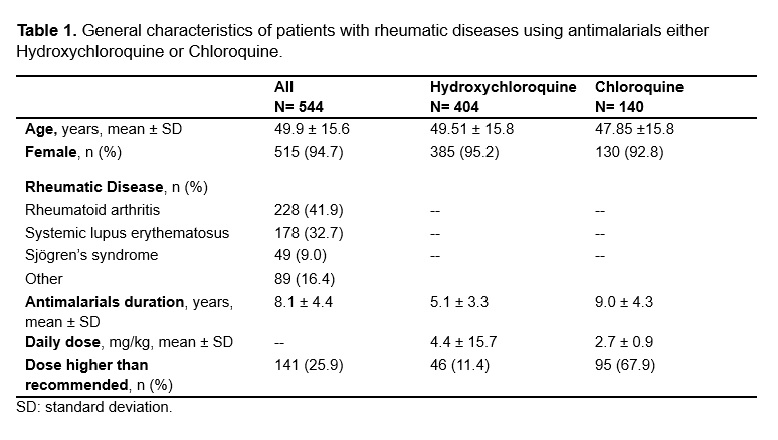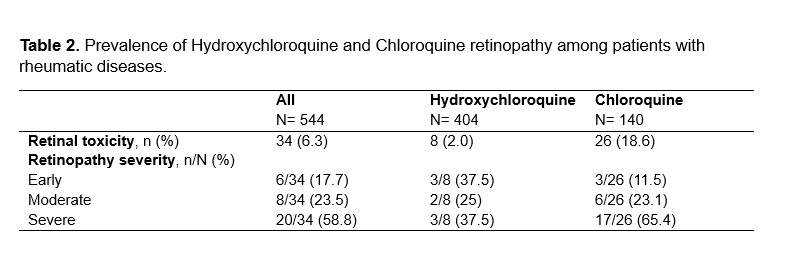Session Information
Session Type: Poster Session A
Session Time: 10:30AM-12:30PM
Background/Purpose: Antimalarial drugs like hydroxychloroquine (HCQ) and chloroquine (CQ) are among the most frequently prescribed medications in Rheumatology. Retinal toxicity is an unwanted side effect of both HCQ and CQ, which in most severe cases could end in reduced vision and blindness. There are still insufficient reports of HCQ or CQ retinopathy in Hispanic patients, and its prevalence and patterns are widely unknown. We aimed to explore the prevalence of HCQ and CQ retinopathy in a Hispanic cohort of patients with rheumatic diseases and describe retinopathy characteristics.
Methods: We performed an ambispective, observational, cohort study between 2014 and 2019 in an academic rheumatology clinic. We included patients with a clinical diagnosis of rheumatoid arthritis, systemic lupus erythematosus, Sjögren’s syndrome, or other rheumatic diseases who were using HCQ or CQ and had a standardized screening evaluation for antimalarial retinal toxicity. The standardized screening tests were a macular optical coherence tomography (OCT) and a visual field test (VFT) with standard automated perimetry (10-2). Demographics, antimalarial medication (HCQ or CQ), treatment duration in years, and the daily dose were documented. We presented the results using descriptive statistics.
Results: Five-hundred and forty-four patients were evaluated, with a mean age of 49.9 (SD:15.6) years and 94.7% (515/544) were female, the most frequent rheumatic diseases were rheumatoid arthritis (41.9%, 228/544), systemic lupus erythematosus (32.7%, 178/544), and Sjögren syndrome (9%, 49/544). Nearly two-thirds of the patients used HCQ (65.3%, 404/544) (Table 1). The duration of use was longer at the time of retinopathy diagnosis for the patients who received CQ (9.04, SD 4.3 years) than those receiving HCQ (5.1, SD 3.3 years). The proportion of patients receiving higher doses than recommended was also greater among patients on CQ (67.9%, 95/140) than those on HCQ (11.4%, 46/404).
Overall, 34 (6.3%) patients had antimalarial retinopathy, Among the patients with rheumatic diseases using HCQ, 2.0% (8/404) had retinal toxicity, and this was higher among CQ users, where 18.6% (26/140) had retinal toxicity. According to the optical severity staging classification of patients with antimalarial retinal toxicity, the retinopathy was mild in 16.64% (6/34), moderate 23.5% (8/34), and severe 58.8% (20/34) (Table 2).
Conclusion: In Hispanic patients with rheumatic diseases, antimalarial retinal toxicity was more frequent among patients with CQ than among patients with HCQ. The retinopathy staging was severe in more than half of the patients.
To cite this abstract in AMA style:
Riega Torres J, Palomo-Arnaud K, Figueroa-Parra G, Morales Wong F, González Cortés J, Mohamed Hamsho J, Esquivel-Valerio J, Galarza-Delgado D, Mohamed Noriega K. Hydroxychloroquine and Chloroquine Retinopathy in Hispanic Patients with Rheumatic Diseases [abstract]. Arthritis Rheumatol. 2024; 76 (suppl 9). https://acrabstracts.org/abstract/hydroxychloroquine-and-chloroquine-retinopathy-in-hispanic-patients-with-rheumatic-diseases/. Accessed .« Back to ACR Convergence 2024
ACR Meeting Abstracts - https://acrabstracts.org/abstract/hydroxychloroquine-and-chloroquine-retinopathy-in-hispanic-patients-with-rheumatic-diseases/


